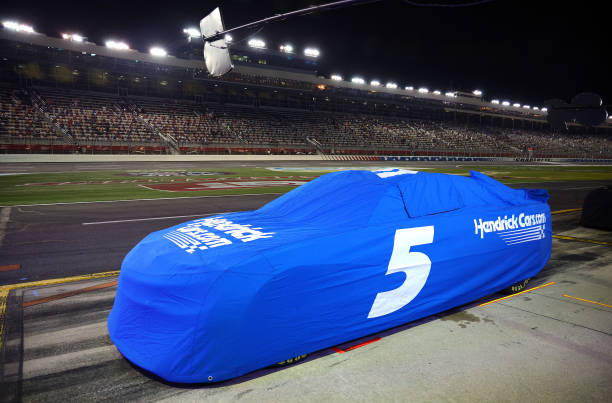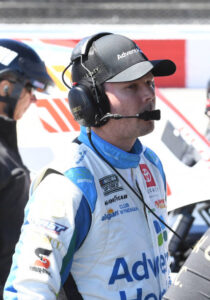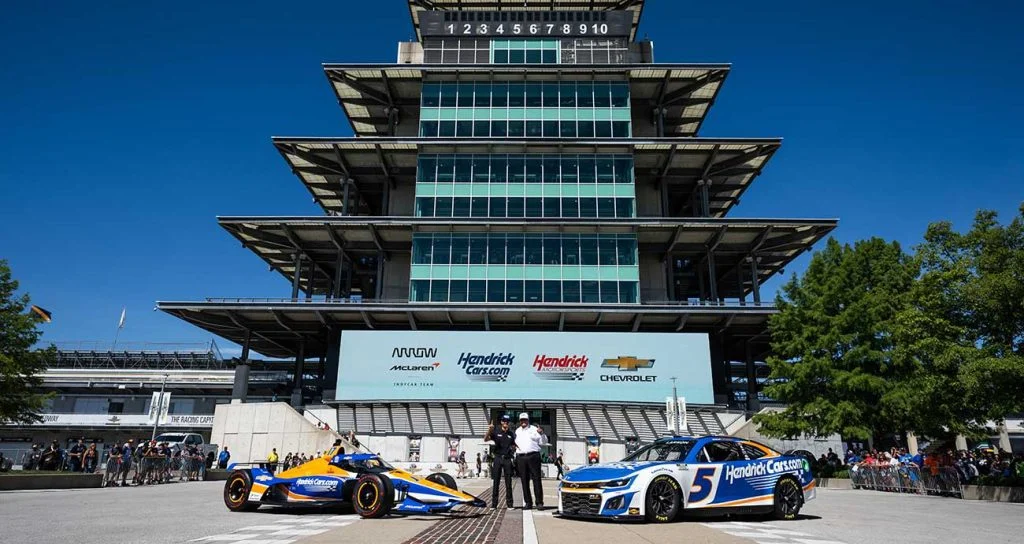What was supposed to be the greatest day of Kyle Larson’s racing career ended up being a massive disappointment. Not only that, but it turned out to be emotionally draining for Larson. Mother Nature reigned supreme on Sunday, turning an attempt at the double into a nightmare. Kyle Larson was forced to choose between running the Indy 500 or Coca-Cola 600 in full. Ultimately, he decided to stay in Indianapolis to run the historic race. That decision was made with the assumed knowledge that NASCAR will grant Kyle Larson a waiver for his playoff eligibility. Per NASCAR rules, in order to be eligible for the playoffs, a driver must run every event held by that series. NASCAR, at its discretion, can give a driver/team a waiver based on appropriate circumstances. From what NASCAR has shown, almost any reason is good enough.
Since the beginning of the playoff era, NASCAR has mandated that every Cup Series driver at least attempt each race on the calendar. This also includes the pre-season The Clash and the All-Star Race/Open. In total, a Cup Series driver needs to run in 38 events to be eligible for the Cup Series Championship. Especially with the “win-and-in” format of qualifying for the playoffs, it does make sense to require a championship contending driver to race in every event. However, NASCAR also implemented a waiver process along with this rule. In theory, NASCAR would use discretion about when to grant a wavier. Instead, NASCAR hands them out seemingly at will. Almost no matter the situation, NASCAR will grant a waiver. Kyle Larson will certainly be no different. However, this shines a glaring light on the farce that is the waiver process.
The Kyle Larson Waiver Situation

As mentioned above, it would be unfathomable that Kyle Larson and Hendrick Motorsports did not receive some form of acknowledgement that a waiver would be incoming. Remember, everyone associated with Hendrick Motorsports (Larson included) were very adamant that NASCAR would come first. If weather was going to be an issue in Indianapolis, Larson would prioritize NASCAR over IndyCar. As the Indy 500 drew nearer, that tone shifted. With the almost certainty of rain altering the Indy 500, the NASCAR first approach of Larson slipped away. On Sunday morning it was clear before any formal announcement, Kyle Larson was going to choose IndyCar over NASCAR.
Understandably, the decision between the two races had to be a difficult one. Running in the Indy 500 has been a childhood dream of Larson’s. It is the most notable motorsports event in the world, with racing fans all over the world tuning in. 340,000 people were attending the Indy 500 this year. This could be a “once in a lifetime” opportunity for Larson.
Yes, the Coca-Cola 600 is a marquee NASCAR event. It is a crown jewel race that rewards the most points of any NASCAR event on the calendar. Kyle Larson was the points leader heading into the race. All these factors surely tugged on Larson’s mind. However, the opportunity to drive in the Indy 500 was too great to pass up, especially if there was no risk to do it.

While NASCAR surely will grant the waiver, the question of should is definitely arising. That should is not based on NASCAR’s precedent, since their waiver history is comical at this point. Rather, should NASCAR actually follow the rule as intended.
Original Intent of the Waiver
When NASCAR implemented the rule that every driver must attempt each event, there was a risk associated with that rule. If a driver has to start every race, what happens when a driver gets injured? Athletes playing through injuries is a common thing, even in NASCAR. However, the increased focus on head trauma brought up the concern of drivers risking health in order to remain championship eligible. There was a concern that still concussed driver would throw aside caution to ensure a playoff status. Plus, other injuries that could hamper a driver’s ability. That is where the waiver comes in.

NASCAR did not want legitimately injured drivers stepping into the seat to maintain their eligibility. This was especially true for injuries that occurred during a NASCAR sanctioned race. If a driver suffers a concussion during a race, NASCAR did not want the driver to be pressured into running the following week with lingering issues. The same could be said for any other injury. Primary example of this would be Erik Jones this season after Talladega. Jones suffered a fractured vertebra from a wreck. With an approved waiver, Jones was able to sit out two races to fully recover from the injury. Now that he has returned, he is eligible for the playoffs if he wins or points his way in.
Injury Debates
Of course, injuries can come from anywhere. Not every injury a NASCAR driver suffers will be in a NASCAR sanctioned event. Last year, two Hendrick Motorsports drivers suffered significant injuries that withheld them from multiple races each. Alex Bowman wrecked and flipped a Sprint Car, resulting in a fractured vertebra that forced him to miss 4 races. Before that, Chase Elliott broke his leg in a snowboarding accident before the spring Las Vegas race. Elliott missed 6 races. Both of these injuries occurred away from a NASCAR sanction event. Still, NASCAR granted a waiver for both drivers.
Nobody wanted either driver to compete with those significant injuries. However, should there be consequences for risking their ability to compete in their fulltime ride via extracurricular activities? Based on NASCAR’s history of approving waivers, there was little debate of whether they would (or should based on historical precedent). However, the debate of letter of the law vs spirit of the law certainly unfolded. If a driver injures himself outside the sport, does that meet a worthy criteria to reward them a waiver?
NASCAR’s inconsistencies with their rulings makes it difficult for fans to support a letter of the law approach. NASCAR clearly leaves wiggle room for themselves, as the waiver rule states NASCAR can approve waivers at their discretion. That can lead to interesting results from certain extenuating circumstances.
Kyle Busch: Cup Series Champion with 25 Starts

For most fans, this might be the most egregious use of the waiver when it comes to an injury. Sure, Elliott and Bowman got injured away from a NASCAR event. However, they only missed 6 and 3 points paying races respectfully. Those 9 combined races are still less than the 11 races Kyle Busch missed in 2015. Despite missing almost a third of the season, Busch left the 2015 season with his first Cup Series championship.
Before the 2015 Daytona 500, Kyle Busch ran the Xfinity Series race. During that race, Busch suffered a broken leg after crashing hard into the inside wall after the front stretch. The injury would keep Busch out of the 18 car until the Coca-Cola 600. Even though he missed almost half of the regular season, NASCAR granted a waiver for Kyle Busch. All Busch had to do was win a race and put himself in the Top-30 in points. Heading into Charlotte, the driver (Tony Stewart) who sat 30th in the standings had scored 147 points to that point. The maximum amount of points a driver could score in a race was 48. It did not take long for Busch to lock himself into the playoffs.
While Busch had a tremendous season, it is tough to stomach the Cup Series Champion for a 36 race season only running 25 races. Especially for fans watching during the Winston Cup days, how can someone win a championship based somewhat on a season’s long point format miss so many races? You do not see other sports league let teams miss a third of the season to then win the championship.
Everyone Gets a Waiver…
Since the inception of the current playoff/points format, NASCAR has granted a waiver for the following reasons:
- On-track injuries
- Illness
- Attending to the birth of one’s child
- Age restrictions (drivers under 18 who are not allowed to compete at certain tracks)
- Off-track injuries
- NASCAR sanctioned suspensions
- Switching points declarations from one series to another
- Replacing a fired driver
With the likely upcoming approval of Kyle Larson, you can add “choosing to compete in a non-NASCAR event instead” to that list. Once again, some of the reasons above are completely valid and deserve a waiver. However, some are certainly up for debate.
If you are a driver that gets a NASCAR enforced suspension, why should you be granted a waiver? Does that not completely undermine the point of the suspension? Many will immediately think of Chase Elliott last year, who got suspended a race for right hooking Denny Hamlin at Charlotte. Granted, that penalty did help lead to Elliott missing the playoffs. Still, if NASCAR finds your actions so egregious that they sit you out a race, why should you still be eligible for the playoffs if you are now violating a different rule?

Sure, it was Chase Elliott so that is why. However, NASCAR did the same thing for Johnny Sauter (2019) and Josh Williams (2022). They suspended both drivers then granted them a waiver for the playoffs. When the regular season points matter so little with the win-and-in format, what is the massive consequence to missing a race from NASCAR’s perspective? The financial backlash comes from the sponsors, disassociated with NASCAR. So if a driver can effectively eliminate the points consequence via a win, what is the point?
Another Kyle Larson situation that saw a different driver get a waiver for the playoffs was Matt Kenseth in 2020. After Larson was indefinitely suspended, NASCAR granted Kenseth a waiver for the driver’s championship. Despite missing the first 4 races, Kenseth got to compete for a playoff spot as if he started the season with the 42 team.
…Except the 4 Who Do Not
Since the waivers were introduced, only 4 drivers have been denied their request. None of these 4 drivers were in the Cup Series.
Spencer Gallagher & Austin Wayne Self

In 2018, Spencer Gallagher was suspended for violating NASCAR’s substance abuse policy. After winning Talladega, Gallagher had to sit out 7 races while going through NASCAR’s Road to Recovery program.
The next year, Austin Wayne Self violated NASCAR’s substance abuse policy. He was suspended by NASCAR and his wavier request was denied. NASCAR denied Gallagher and Self of their waiver requests, which is the expected (and logical) decision.
Kaz Grala

Also in 2018, Kaz Grala was denied a waiver when running in the Xfinity Series. Grala started the season with JGL Racing and ran the first 10 races in their 24 car. However, the team shut down after Dover. FURY Race Cars would pick up Grala for the next 6 races. However, they were unable to field a car for Kentucky, meaning Grala missed the race. NASCAR denied Grala’s waiver request despite entering the following race at New Hampshire. Poor luck essentially ended Grala’s 2018 season, with NASCAR handing down a waiver denial.
Grant Enfinger

Similar to Grala, Grant Enfinger missed a Truck Series race in 2021 due to funding issues. ThorSport announced prior to the season that Enfinger would drive part-time for them. Enfinger drove the opening race at Daytona, but could not get a ride together for the Daytona road course. NASCAR denied his waiver request, despite Enfinger going on to start every race after the Daytona road course. Of the four, this might be the most baffling decision.
Bottom line, you can actively choose to skip a race and (potentially) receive a waiver. However, do not miss a race due to financial issues because there is no sympathy from NASCAR, especially in the lower series.
Should NASCAR Give Larson a Waiver?
Based purely on precedent, yes. Despite the two questionable times that NASCAR has denied a waiver request, NASCAR should give Kyle Larson a waiver for the playoffs despite missing the Coca-Cola 600. Especially considering NASCAR likely already gave Larson and Hendrick Motorsports the okay, they should not deny the waiver.
With that said, the principled and correct choice would be to deny Kyle Larson the waiver. While there are plenty of arguments that support each side, there are two that stand out as to why NASCAR should not give Larson the waiver.
The 2015 Rule Update
In 2015, NASCAR updated the language surrounding the rule about enforcing a driver to race each event to be playoff eligible. Prior to 2015, the rule only stated that a driver only had to attempt to qualify for each event. By letter of the law, a driver could show up Saturday/Friday to qualify then miss the actual race and still be playoff eligible. NASCAR updated the rule to state that a driver would have to attempt to qualify for each event. If they qualify for the event successful, then that driver would have to start those races in which they successfully qualified for.
Simply put, a driver has to start every race in their respective series. The interesting thing about this rule change was a potential reason why NASCAR implemented it: Kurt Busch. In 2014, Busch became the most recent driver to complete the double. He managed to run the entire Indy 500 then made the trip to Charlotte to run the Coca-Cola 600. Albeit, he did DNF the 600. However, NASCAR updated the rule to prevent a loophole from being used. With the old rule, a driver could qualify on Saturday for the 600, then miss the race if something happens in Indianapolis without losing eligibility.

Per NASCAR’s own article about the rule change, this rule update should prevent exactly what happened Sunday. Larson went to Charlotte to practice and qualify the 5 car, returned to Indianapolis to then choose to stay there when it became a choice between the Indy 500 and Coca-Cola 600. NASCAR wanted to make sure their drivers choose to compete for them over IndyCar. If they give the waiver to Larson, that cannot be a decision based on the principle of the rule.
Kyle Larson’s 2-Year Deal

When it was announced Kyle Larson would be attempting the double last year, the contract was for 2 years. Per the team, this was a cautious provision put in place in case something happened to mess up the schedule. In essence, the 2-year commitment was a safety net in case rain (or other circumstances) would push the Indy 500 to interfere with Larson’s ability to run the Coca-Cola 600. Larson could attempt the double next year, hoping for better luck.
Instead, Kyle Larson decided to continue with the Indy 500 despite having the option to race it next year. Once again, that decision was made with the likely knowledge of no consequences from NASCAR. Still though, the Coca-Cola 600 is NASCAR’s second biggest race of the season. It is a marquee event held on Memorial Day that draws sold out crowds and larger than usual TV audiences. If that is not important enough to miss the Indy 500 knowing you have the opportunity next year to do it, then what type of message does that send?
Based purely on the principle of the rule, Kyle Larson should not get a wavier.
Change the Rule
Before angry Kyle Larson fans start commenting in all caps, Kyle Larson should still be able to compete for the championship. The waiver should come his way once Hendrick Motorsports officially applies. Larson running the Indy 500 is not the glaring issue here. It is the rule and waiver process. Simply put, it is a giant farce.
The original intent for the rule requiring drivers to start all events was to eliminate drivers sitting out their weaker tracks (most notably road courses) and taking advantage of the playoff points system. Without the rule, theoretically Kaulig Racing could put AJ Allmendinger in the 16 car only for the road courses in the regular season, go all out to attempt to win, then wait for the playoffs to let him drive fulltime. However, NASCAR is answering a poorly laid out system by implementing a bad rule. Not only a bad rule, but a system in which that bad rule can be easily shot down.

In an ideal world, the points would revert back to the Winston Cup format. Larson missing the Coca-Cola 600 hurts him in his quest for the championship, allowing for a consequence for missing the race. However, it is a challenge to overcome and does eliminate him from contention. Best of both worlds. That also allows any suspensions to hold more weight since a win does not grant access the 10-race championship hunt. However, that is unrealistic.
Realistically Though
What can NASCAR do instead since the playoffs are here to stay? One thing would be to reimplement a points standing requirement for the automatic win berth to be applied. Instead of 30th though, make it at least Top-20. A driver sitting 29th in points who pulls a win out of nowhere should not be eligible to win a championship over someone in the Top-10 in points without a win. Honestly, doing away with the “win-and-in” format would be great as well. Once again, NASCAR would not do that.
NASCAR truly needs to get out of their own way and stop putting themselves in positions to make decisions like this. Their history of inconsistencies makes this process incredibly frustrating to monitor. If you have a rule, enforce it. Make it clear what exceptions can apply to said rule and keep it black and white. No more guess work or debate. If not, then do not have the rule.
NASCAR is going to grant Kyle Larson a waiver. They should do it based on their own history. However, it further proves that the rule for drivers to start every race is not enforceable and the waiver process is a complete joke. Essentially, NASCAR can dictate whatever they want, whenever they want. That is broken system.


